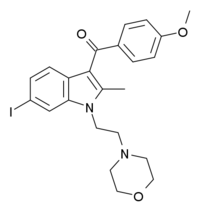AM-630
AM-630 (6-Iodopravadoline) is a drug that acts as a potent and selective inverse agonist for the cannabinoid receptor CB2, with a Ki of 32.1 nM at CB2 and 165x selectivity over CB1, at which it acted as a weak partial agonist.[1][2] It is used in the study of CB2 mediated responses and has been used to investigate the possible role of CB2 receptors in the brain.[3][4] AM-630 is significant as one of the first indole derived cannabinoid ligands substituted on the 6-position of the indole ring, a position that has subsequently been found to be important in determining affinity and efficacy at both the CB1 and CB2 receptors, and has led to the development of many related derivatives.[5][6][7][8][9]
 | |
| Legal status | |
|---|---|
| Legal status |
|
| Identifiers | |
| |
| CAS Number | |
| PubChem CID | |
| IUPHAR/BPS | |
| ChemSpider | |
| UNII | |
| ChEMBL | |
| CompTox Dashboard (EPA) | |
| ECHA InfoCard | 100.229.964 |
| Chemical and physical data | |
| Formula | C23H25IN2O3 |
| Molar mass | 504.368 g·mol−1 |
| 3D model (JSmol) | |
| |
| |
| | |
See also
- AM-1221
- Pravadoline
- WIN 54,461 (6-Bromopravadoline)
References
- Ruth A Ross; Heather C Brockie; Lesley A Stevenson; Vicki L Murphy; Fiona Templeton; Alexandros Makriyannis; Roger G Pertwee (February 1999). "Agonist-inverse agonist characterization at CB1 and CB2 cannabinoid receptors of L759633, L759656, and AM630". British Journal of Pharmacology. 126 (3): 665–72. doi:10.1038/sj.bjp.0702351. PMC 1565857. PMID 10188977.
- Murataeva, N.; MacKie, K.; Straiker, A. (2012). "The CB2-preferring agonist JWH015 also potently and efficaciously activates CB1 in autaptic hippocampal neurons". Pharmacological Research. 66 (5): 437–42. doi:10.1016/j.phrs.2012.08.002. PMC 3601544. PMID 22921769.
- Morgan NH, Stanford IM, Woodhall GL (September 2009). "Functional CB2 type cannabinoid receptors at CNS synapses". Neuropharmacology. 57 (4): 356–68. doi:10.1016/j.neuropharm.2009.07.017. PMID 19616018.
- Ishiguro H; et al. (May 2010). "Brain cannabinoid CB2 receptor in schizophrenia". Biological Psychiatry. 67 (10): 974–82. doi:10.1016/j.biopsych.2009.09.024. PMID 19931854.
- Eissenstat, M. A..; et al. (1995). "Aminoalkylindoles: Structure-Activity Relationships of Novel Cannabinoid Mimetics". Journal of Medicinal Chemistry. 38 (16): 3094–105. doi:10.1021/jm00016a013. PMID 7636873.
- Hongfeng Deng. Design and synthesis of selective cannabinoid receptor ligands: Aminoalkylindole and other heterocyclic analogs. PhD Dissertation, University of Connecticut, 2000.
- Hynes J; et al. (September 2002). "C-3 Amido-indole cannabinoid receptor modulators". Bioorganic & Medicinal Chemistry Letters. 12 (17): 2399–402. doi:10.1016/S0960-894X(02)00466-3. PMID 12161142.
- Frost, J. M.; et al. (2008). "Indol-3-yl-tetramethylcyclopropyl Ketones: Effects of Indole Ring Substitution on CB2 Cannabinoid Receptor Activity". Journal of Medicinal Chemistry. 51 (6): 1904–12. doi:10.1021/jm7011613. PMID 18311894.
- Adam, J. M.; et al. (2010). "Design, synthesis, and structure–activity relationships of indole-3-carboxamides as novel water soluble cannabinoid CB1 receptor agonists". MedChemComm. 1: 54. doi:10.1039/c0md00022a.
This article is issued from Wikipedia. The text is licensed under Creative Commons - Attribution - Sharealike. Additional terms may apply for the media files.